The Surface 3 Review
by Brett Howse on May 4, 2015 9:00 AM ESTSystem Performance
Since the Surface 3 is a tablet that can replace your laptop, comparisons will be made between both devices. Because the new tablet is running full Windows 8.1 x64, it is possible to run the full benchmark suite that we have for laptops. On the tablet side, there are not a lot of cross-platform benchmarks so the only thing that can really be used is browser based tests. It is not ideal, but we have to work with what we have.
To summarize the Surface 3, it is powered by the top model of the latest Intel Atom 14nm stack. The Atom x7-Z8700 is a quad-core processor with a base frequency of 1.6 GHz. The CPU can turbo up to a maximum of 2.4 GHz, and all of this is done within a 2 watt Scenario Design Power. The review unit that I received is the $499 unit, so it only has 2 GB of LPDDR3 memory rather than the 4 GB offered on the higher priced model.
For comparisons against tablets, I have selected a sampling of several devices that have already been reviewed. Some of the devices are running on ARM processors, and several of the Windows ones run on Intel Core M, with a few more running on previous Atom architectures. To compare this device against any other device we have tested, please check out our Mobile Bench.
Tablet Performance
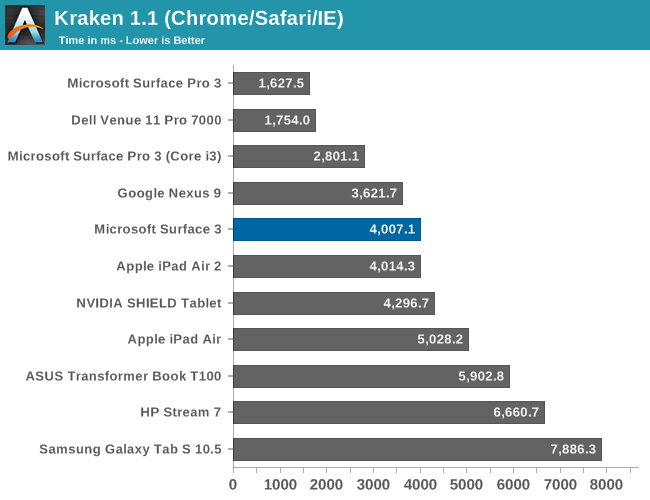
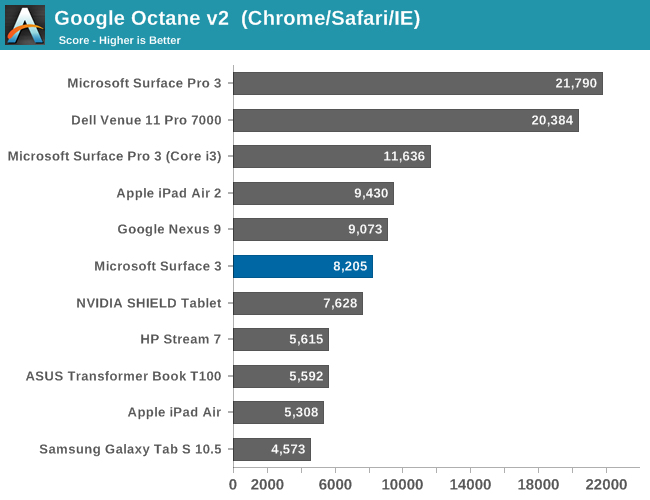

Since we just have web benchmarks to compare against other platforms, it does make it difficult to get a true feel for how Atom compares to the best, but when comparing to ARM processors it is fairly competitive. All of the web benchmarks are done using Chrome (hopefully we can switch to Microsoft Edge soon) because IE 11 has pretty awful javascript performance. Atom is a long ways off of the Core series in the Surface Pro line, and well back of the Core M powered Dell Venue 11 Pro tablet. There is a big jump in performance compared to the Bay Trail ASUS T100 and HP Stream 7. That is important since Cherry Trail is not a big architecture update, but mostly a process shrink, so the 14 nm processes can keep everything running at higher frequencies in the same power envelope.
Laptop Performance
By attaching the keyboard, the Surface 3 becomes a pretty reasonable laptop, so to see how much of a performance drop off there is with tablet class parts, the Surface 3 was run through our Laptop suite as well. The Atom is also equipped with eMMC storage, and some of the tests like PCMark take storage into account. Other benchmarks like Cinebench and x264 are CPU only. To compare the Surface 3 against any other laptop we have tested, please use our Laptop Bench.
PCMark

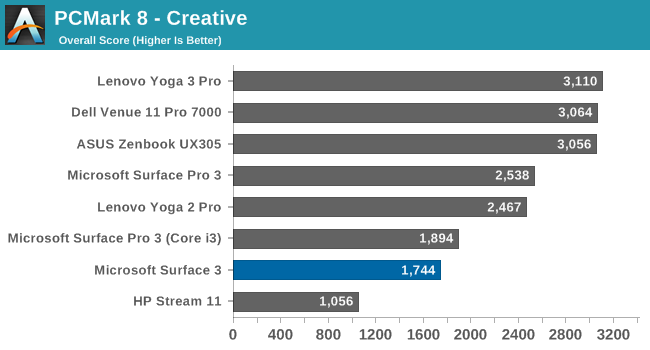
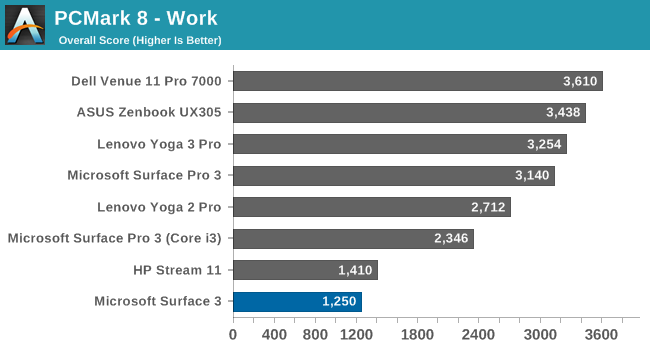
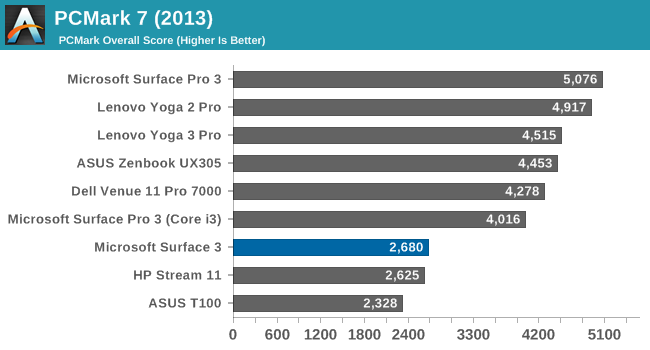
PCMark 8 from Futuremark has several benchmarks within it, all with the goal of simulating real-world use cases for each of the scenarios. It includes Home, Creative, Work, and Storage benchmarks. The workloads generally include both burst and sustained performance. The Atom can’t compete with the bigger Core pieces, but it is actually surprisingly close to the Core i3 Surface Pro 3. I think this is less about Atom and more about how handicapped Core i3 is with its lack of Turbo.
TouchXPRT


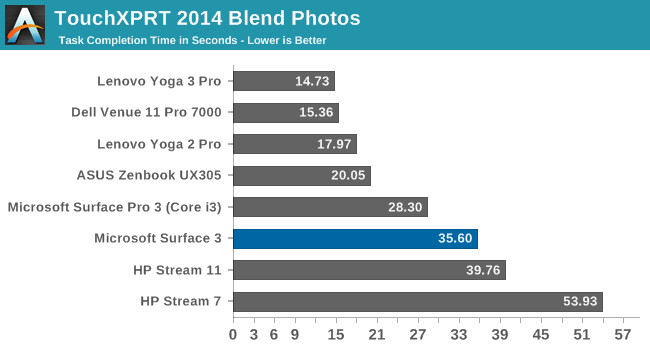
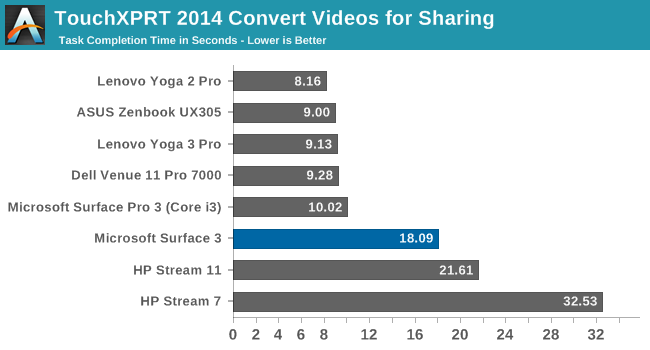
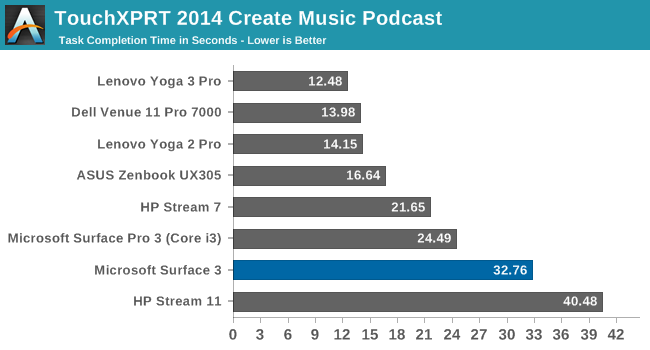
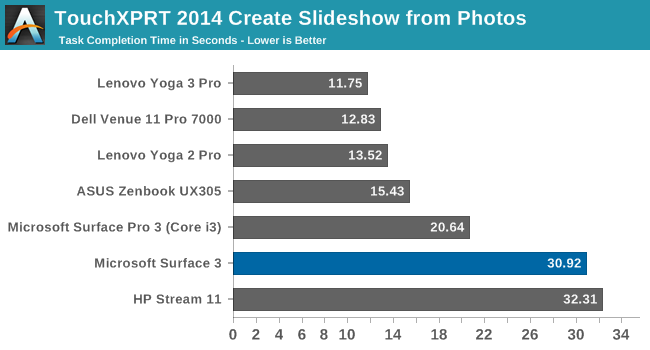
TouchXPRT 2014 is a benchmark that has a lot of burst workloads. The tasks are quick, but heavy, and it gives the processor a quick chance to cool off between each one so normally it is good about not running into throttling behaviour. The Atom processor is a long way off of the Core series here, with the exception of the i3 Surface Pro 3 which has no turbo capability. However there is a good bump in performance over the previous generation Atom in the HP Stream 7.
Cinebench

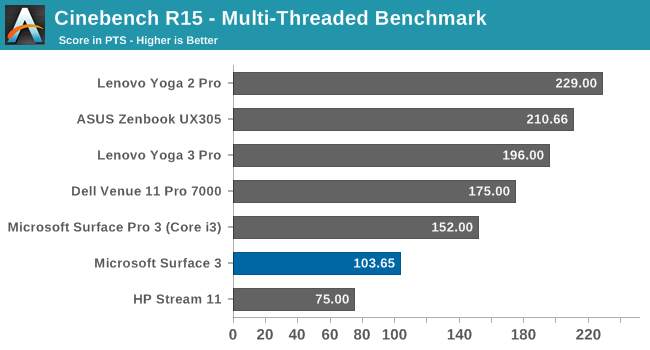
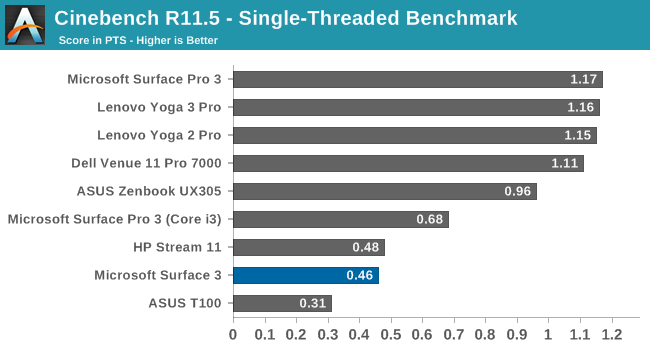
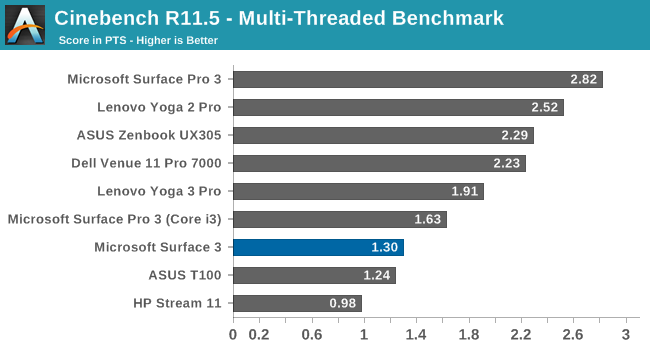
Cinebench is purely a CPU task, and it loves Instructions Per Clock (IPC) and frequency. There are two modes here with a single CPU run and all core run. It is still a long ways back of the Core i3 Surface Pro 3 on this test, and despite the Atom processor having four physical cores and the Core processors having only two physical and four logical cores, it is still not enough on the multithreaded run to really close the gap, although it does slightly. Looking at version 11.5 of this test, we have more data going back to older devices, so there are scores available from the ASUS T100 and there is a bump in performance compared to Bay Trail.
x264
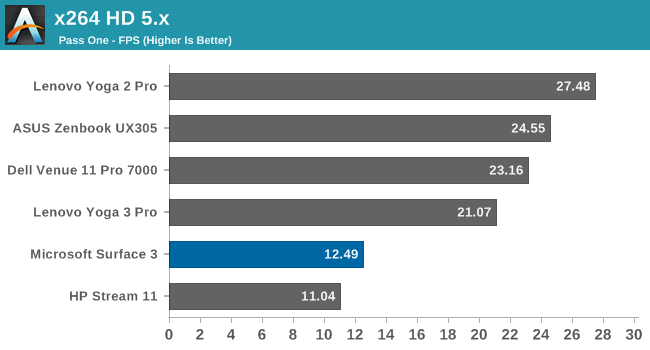

Once again this is a benchmark that prioritizes good IPC and frequency, along with multiple cores. The Atom struggles here compared to Core, which at this point should not be a surprise.
So clearly the new Cherry Trail CPU cores are not a giant leap in performance over Bay Trail, but like Haswell to Broadwell, there is a decent bump and the better manufacturing process helps increase overall performance due to the additional thermal headroom in the same power envelope. However when comparing it to the ARM competition, we only have a few data points but it does seem to be about on par with the top ARM CPUs at this time. Comparing devices across different operating systems is always difficult though.
Using the device day to day as a tablet though, performance was good. Yes, it could be better, and devices that use Core M are going to be able to run circles around Atom, but at the cost of additional heat. One of the nicest surprises of using this tablet was that it just never got warm at all, and the same cannot be said of any of the passively cooled Core M devices. Sure, when running very heavy benchmark loads, there was a bit of heat on the back, but it was never much more than around 30°C or so.
My experience was that when the Surface 3 felt slow, it was often not CPU bound but disk bound.










265 Comments
View All Comments
MrTetts - Tuesday, May 5, 2015 - link
The IPad is ALWAYS going to be an inferior product regardless of use case.1. For video/media consumption - you would have access to more media players, more content markets (than just the itunes store) and simply more choice overall.
2. For media/content creation - You do not even have this option (or intergrated well enough) on an IPad.
3. Basic office duties - We can all agree that any office applications on an IPad would be very watered down and frankly quite useless. If you have to buy a keyboard to access an application properly on an ipad, then my friend, I have news for you... your use case clearly aligns you to a surface 3.
An IPad is no where near up to par. You are getting a very big IPod Touch for your money. Don't give in to the marketing from Apple telling you you can be productive on an IPad...
V900 - Tuesday, May 5, 2015 - link
Oh my holy God! Amazing! Through some sort of quantum fluctuation in some internet backbone somewhere, a wormhole in space time has made your post appear three years into the future!Hello there Anandtech reader from 2012! We hear you loud and clear this is Anandtech 2015! As for your points, a lot has changed/will change from your perspective!
1: IPads in 2015 are better for using content... The vast majority of video is in MP4 formats. The few formats an iPad can't decode natively you can get a third party app for in the AppStore for a few dollars or free. As for content, the vast majority is available through the web or (usually) free third party apps.
2: Content creating: In 2015 its a clear win for the iPad if you want to use a touchscreen. It's not even close with Windows tablets. Adobe for example has over 20 apps for iPad. In your future and my present, even content creation suites that used to only be available for PC/Macs have an iPad app solution available as well.
3: Basic Office: everyone in your time that is skeptical about Microsofts plans are right. In 2015 there is a
multitude of office solutions for iPads, and even Microsoft have given up and gone all in on the platform... The MS Office for iPad is on par with the MS Office for Windows, and blows MS Office for Touch Windows completely out of the water. Microsoft of the future will bet big on iOS...
Take care 2012 Anandtech reader! Oh, I probably cant tell you much about this, but be careful with the middle east! There is a group in Iraq that you really shouldn't underestimate... They will wreck some major chaos later in the timeline if you don't try to stop them in 2012!
damianrobertjones - Wednesday, May 6, 2015 - link
Yet if you type one line of text on the ipad it's a great big pain in the rear to edit. Where's the back arrow key? I've an Air 2 and, being honest, it's a pain to use for anything serious. Heck the other day I just wanted to copy some comics onto the thing... usually I'd just slap them on but instead I had to place them onto the network, launch an app, log in and then read.The app situation will improve when Windows 10 hits but, until then, I'll be happy to just launch the FULL application.
digiguy - Wednesday, May 6, 2015 - link
how much nonsense in a single post.... You probably don't know how to use Office and Adobe professionally.... or you live in 2015, but on a different planet... My ipad air is a great device, but that's far from being the machine to work on....Michael Bay - Wednesday, May 6, 2015 - link
>MS Office for iPad is on par with the MS Office for WindowsIf you step aside from pure lulz one has with such a comment, it`s quite sad that sheeple actually believe that.
MrTetts - Tuesday, May 5, 2015 - link
Bottom line is...If you're in the market for an iPad. Consider the Surface 3 for the 'Just In Case' factor.
1. Just in case you want to edit a word document properly.
2. Just in case you want to create media.
3. Just in case you want to download movies/music from a website.
4. Just in case you want to use adobe products.
5. Just in case you don't want to connect the tablet to your TV.
6. Just in case you want to charge your phone using a tablet.
7. Just in case you actually want to write notes in class/during meetings at the office.
8. Just in case you want expandable memory.
9. Just in case you don't want to be locked into the apple ecosystem.
10. Just in case you save things to a memory stick, rather than a cloud which you get charged for.
and i could go on... Just consider the Surface 3.. Just in case.
V900 - Tuesday, May 5, 2015 - link
OMG! The wormhole is still open!LOL! Read my other post Anandtech from 2012! Nothing on your list is accurate or will matter much in 2015...
Both Adobe and Microsoft have gone all in on iPads. Adobe has over 20 apps on iOS, and nothing on Windows that you'd bother running on a touchscreen or with a tablet class processor.
Don't consider the Surface 3. Not even for just in case. You can always get either a better laptop or a better tablet for the same
money. The Surface 3 is worthless, considering that for 500-600$ you can get an alright laptop AND an iPad mini: Beat of both worlds!
damianrobertjones - Wednesday, May 6, 2015 - link
Or a Surface Pro 3.Michael Bay - Wednesday, May 6, 2015 - link
Do they at least pay you for this drivel?kyuu - Wednesday, May 6, 2015 - link
How in the hell is carrying two devices -- one of them a crappy laptop, the other a tablet with a small screen that's basically just an oversized iPhone -- the best of both worlds?